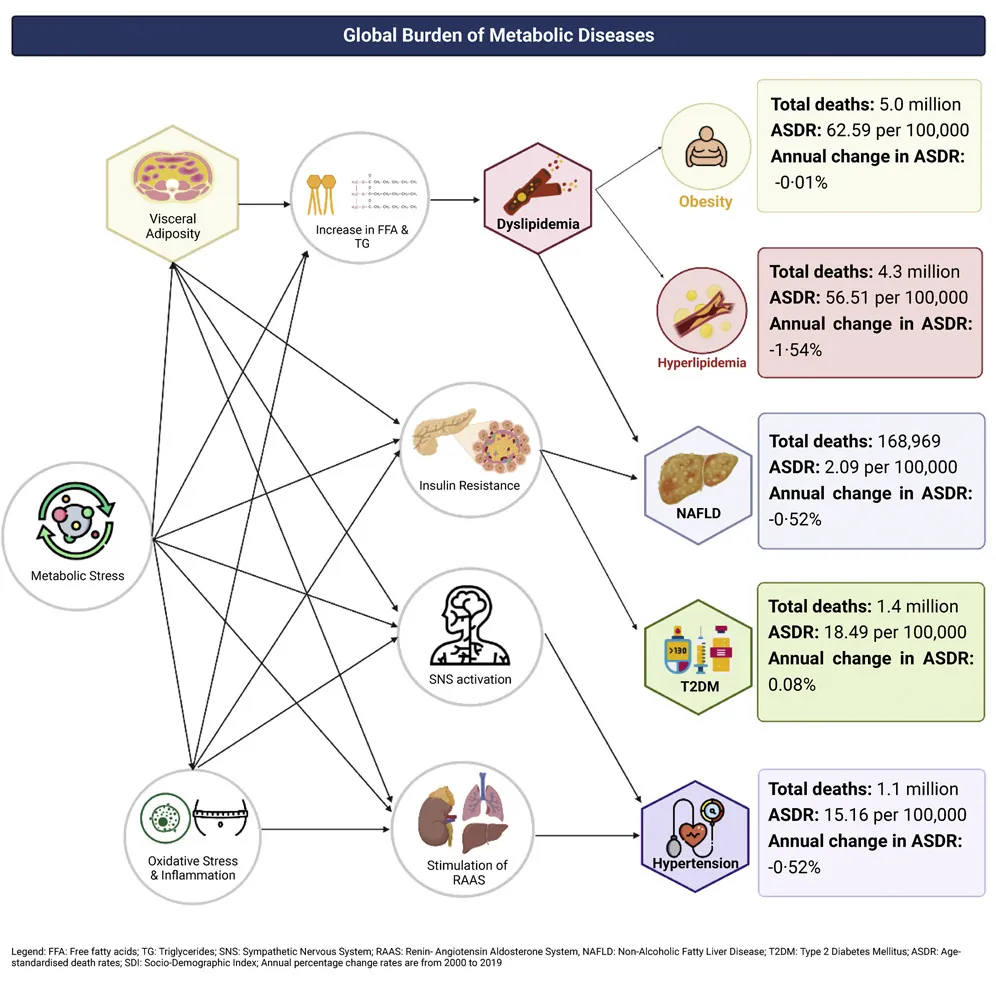A new paper published in Cell Metabolism has shown the growing influence of metabolic diseases in an aging population.
Related diseases studied together
Metabolic diseases include hypertension, type 2 diabetes, hyperlipidemia, obesity, and non-alcoholic fatty liver disease [1]. These diseases, representing fundamental problems with how the human body uses energy, are heavily linked to systemic inflammation [2].
The authors note that previous studies relating to these metabolic diseases have measured each of them independently. This paper looks at these diseases collectively, from a public health perspective, treating these non-communicable diseases with the same gravity as a pandemic.

Prevalence and mortality
This study, which was based on 2019 data, estimated that there were a full 43.8 million cases of type 2 diabetes, 18.5 million cases of hypertension, and a full 1.2 billion cases of non-alcoholic fatty liver disease: roughly a seventh of the world’s population. The other two diseases could not be accurately measured.
Between 2000 and 2019, when controlling for age, the per-capita death rate has been either holding steady or, in the case of hyperlipidemia, on a downtrend. Of course, with an aging and growing population, the absolute number of people dying from these diseases has been growing rapidly. Globally, obesity was the main contributor to these metabolically related deaths; however, this varied greatly by countries, with poorer countries being less obese and more prone to diabetes-related mortality after standardization for age.
Non-alcoholic fatty liver disease substantially increased, even after adjustment for age, particularly in males. The prevalence of this metabolic disease increased almost a full percentage point every year from 2000 to 2019, a situation that the authors describe as “alarming”. Fortunately, the total amount of suffering and death, as measured by disability-adjusted life years (DALYs) and mortality, seemed to decrease for people who have this disease. The authors hypothesize that this might be due to increased diagnosis of this disease, even when its symptoms are not particularly acute.
Recommendations
As this is a policy-oriented study for global health, the authors spend time discussing what might be done. They hold that the current environment for most people is obesogenic, tending towards diets and practices that lead to obesity, and they list genetics and modifiable risk factors such as smoking and sedentary lifestyles. They also note that type 2 diabetes medications that protect against cardiovascular events might reduce the death and suffering caused by such events [3].
Conclusion
The elephant in the room is, of course, aging. The authors specifically tune their analysis to exclude the effects of aging and differentially aged populations for exactly this reason; aging has a drastic effect on everything they are attempting to measure.
However, the unspoken assumption, on both an individual and population level, is that it is not modifiable. Therefore, treatments that focus on the age-related root causes of metabolic diseases are not mentioned, and the policy recommendations given are those that are well known but very hard to implement on a wide scale: diet, exercise, and other lifestyle-related habits.
As this paper points out, the total death and suffering caused by metabolic diseases is enormous: more than ten million people died of such diseases in 2019 alone. If policymakers are going to do something about them, they would be well-advised to look for interventions that strike them at their root.
Literature
[1] Ng, C. H., Wong, Z. Y., Chew, N. W., Chan, K. E., Xiao, J., Sayed, N., … & Muthiah, M. (2022). Hypertension is prevalent in non-alcoholic fatty liver disease and increases all-cause and cardiovascular mortality. Frontiers in Cardiovascular Medicine, 9.
[2] Sethi, J. K., & Hotamisligil, G. S. (2021). Metabolic Messengers: tumour necrosis factor. Nature metabolism, 3(10), 1302-1312.
[3] Chew, N. W., Ng, C. H., Muthiah, M. D., & Sanyal, A. J. (2022). Comprehensive review and updates on holistic approach towards non-alcoholic fatty liver disease management with cardiovascular disease. Current Atherosclerosis Reports, 24(7), 515-532.







